Deciding which text analysis software is right for your business is a challenge. Before committing to new software, you want to ensure that it will be beneficial to your specific needs and that your employees will find it helpful and easy to implement and adopt.
To support you in the decision process, we’ll define the basic and standard features of text analysis tools and how Symanto addresses some of the recurrent challenges users encounter with these tools. Plus, the best text analysis solutions available at the moment.
What Is Text Analysis Software?
Text analysis software, sometimes called text analytics or text mining software, is a software application used to analyse text.
Whichever name it goes by, this software uses natural language processing (NLP) and machine learning to provide insights into any kind of written text data (structured or unstructured).
These insights are then converted into visual representations of the data (graphs and charts) to facilitate interpretation. Symanto Insights Platform is an example of text analysis software.
Sources of text data mined by text analysis software include (but are not limited to) surveys, online reviews, qualitative marketing research, emails, call transcripts, forums, social media, and other documents.
Generally, text analysis software is used to analyse customer and employee satisfaction. This helps businesses measure and make changes to their marketing and branding strategies or inform them of opportunities for product innovation.
Some text analytics tools can also be used to perform competitor analysis, measure brand health and brand equity, conduct due diligence checks and classify documents.
Common Features of Text Analysis Software
Here are some features you can expect from text analysis software. Take a look and decide which of these characteristics is relevant to your needs, and then check which software offers them.
Import text data from multiple data sources
Some text analysis software specialises in importing text from specific sources, e.g. surveys. However, given the broad potential applications of text analysis, it’s helpful to have the possibility to import data from a large variety of data sources.
For example, your service team could import data from call transcripts, review sites and social media to get a more comprehensive view of the challenges they face. While your HR department could import data from employee review sites and surveys.
The more flexibility you have, the more the chosen software can be applied across your business, and the more you will get from your investment.
Natural Language Processing (NLP)
Natural language processing allows for advanced text analysis. Words can be understood contextually, permitting greater accuracy and more reliable insights.
NLP includes:
- Language identification: understanding which language the text was written in.
- Part of speech tagging: individual words are tagged as a verb, noun, adjective, preposition, etc.
- Syntax parsing: this is similar to part of speech tagging but looks at the sentence as a whole to understand how it was constructed.
- Topic/Keyphrase extraction: identify the themes in a text.
Sentiment analysis
The features of NLP are then applied to determine whether a text is positive or negative. And what emotions are communicated in the writing (joy, anger, etc.)
Such information can be cross-tabulated with the topics to discover sentiment around a particular product or feature.
Data visualisations for more precise insights
Data is organised into graphs and charts to help users interpret data and extract insights.
Common Challenges with Text Analysis Software
Before deciding which text analysis software to invest in, bear these common challenges in mind:
Need for human analysis
Text analysis software is just a tool to help us interpret the data. Ultimately, it’s up to you and your employees to assign meaning to the data. That means you need skilled personnel to read the insights and convert them into actionable points for your business.
Data collection
Depending on the tool you choose and the data you need to import, you may have to prepare and collect it manually before feeding it into the text analysis software. You may need the help of a dedicated specialist to format the data appropriately for the text analytics tool.
Fortunately, most text analysis software doesn’t require structured data, so the work is less time- and resource-intensive than analysing structured quantitative data.
User reluctance
Introducing new software to any organisation comes with the challenge of encouraging employees to adopt it and make the most of it.
Departments have developed their own way of doing things and created systems they’re comfortable with. Thus, convincing them to regularly use new software is not always easy. This is especially true if the software is unintuitive and complicated to use.
To increase adoption rates, ensure managers and team leaders actively advocate using new technologies. And onboard users in all relevant departments to confidently use new software.
Best Text Analysis Software
Symanto Insights Platform
Symanto Insights Platform is an AI text analysis tool that facilitates high adoption rates by focusing on usability.
Easy data collection from varied sources
Symanto Platform easily imports data from 75 online portals, including Amazon, Trip Advisor, Facebook and Glassdoor.
It also integrates with SurveyMonkey and Typeform, meaning you can import data within a few clicks.
You can also easily upload all kinds of textual data as Excel or CSV files from, for example, your CRM.
The ease with which you can prepare data and the variety of data sources ensure you can make the most of our platform across your organisation.
Intuitive interface and clear data visualisation
Our Symanto Insights Platform’s intuitive interface makes it incredibly simple to navigate. The platform walks you through how to use it step-by-step, and interactive data visualisation enables you to delve down and explore your insights on a granular level.
Extra services to help you make the most of the platform
Symanto is designed to be used by your average employee, but there are times and scenarios in which the help of an analyst would be beneficial.
If you think you would benefit from the help of an analyst to interpret your data, but you don’t have the bandwidth within your organisation to hire one, Symanto also offers services to create tailored, insights-driven strategies and reports.
Symanto Features
- Topic identification – Create a strong marketing strategy by better understanding your target audience’s pain points.
- Psychographics – Profit from advanced psychographics to personalise your brand and marketing messaging.
- Brand recommendations – Compare your brand’s health with that of your competitors and check your brand from consumers’ point of view.
- Timeline – Evaluate customer sentiment and engagement over time and your business marketing results evolution.
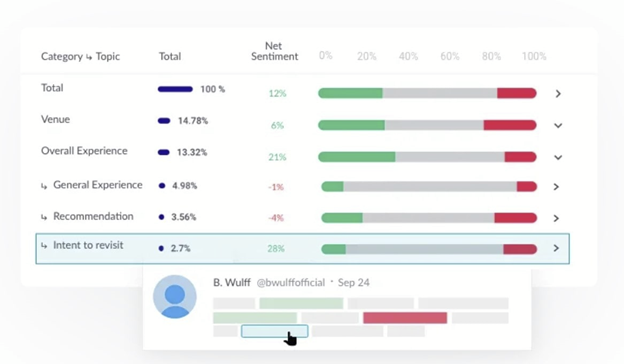
Symanto Benefits
Symanto’s self-service platform allows your business to collect all the needed data from online sources. And execute a laser speed analysis to obtain in-depth brand insights that go beyond sentiment and ratings.
These are your business’s benefits:
- Collect millions of online reviews and pull advanced consumer insights.
- Discover actionable user insights via psychology AI.
- Leverage accurate sentiment based on topic and integral text.
- Get advanced opinion analysis personalised for customers and employees.
- Improve decision-making by transforming text into critical metrics quickly.
- Tailor your dataset analysis model to easily modify sentiment and topics based on your niche requirements.
Book a personalised demo
We offer free personalised demonstrations to help you understand the multitude of applications of Symanto for your business. See for yourself how intuitive and valuable the Symanto Insights Platform is for your business before purchasing our software.
Book your free appointment today, or get in touch for more information.
| Advantages | Disadvantages |
|---|---|
| Advanced and actionable insights | Slight learning curve |
| AI-powered | |
| Visualisation features | |
| Powerful sentiment analysis | |
| Psychographics | |
| Context analysis |
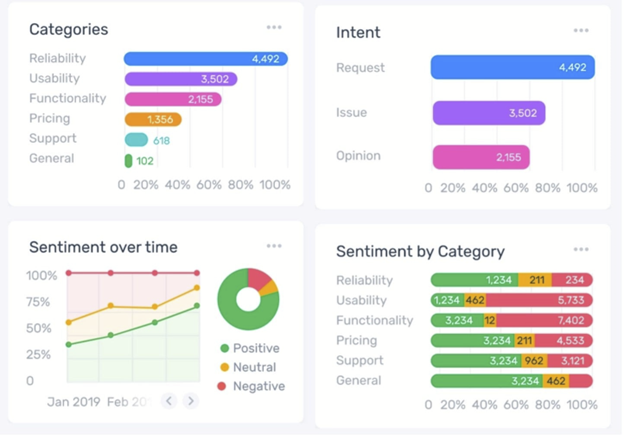
MonkeyLearn claims to be a “no-code” text analytics software solution that examines text automatically with the help of AI and delivers insights based on this data.
Machine learning algorithms allow you to extract keywords, classify text and intent, detect language and execute sentiment analysis. Text analysis is automated and has the capability to examine your texts in a matter of minutes, particularly if you have a personalised model.
You can quickly build your model using data templates but need to define the text classifiers. With their help, you can nail the topic, intent, sentiment, urgency, etc. Text extractors will be used to streamline the processing and structure of the data.
MonkeyLearn proposes features like:
- Pre-made templates to simplify text analytics. You have at your disposal a collection of templates applicable to various scenarios and analysis models.
- Elaborated insights displayed in a visually appealing manner. Quick text analysis with insights delivered almost instantly, accompanied by charts and visuals that ease the interpretation.
- Machine learning models. Build and train a personalised model for your businesses without knowing how to code, but you need to clean your data first.
- Integration with other apps like Zapier, Service Cloud, Zendesk, Freshdesk, Typeform, Survey Monkey, Qualtrics, etc.
They are the power behind data-driven companies like Freshly, MoxiWorks, Garmentory, Golden Proportions Marketing and more.
| Advantages | Disadvantages |
|---|---|
| Advanced insights | Difficulties in processing extensive volumes of data |
| AI-powered | You have to train the algorithm and clean the data |
| Visualisation features | Inflexible pricing model |
| Collection of templates |
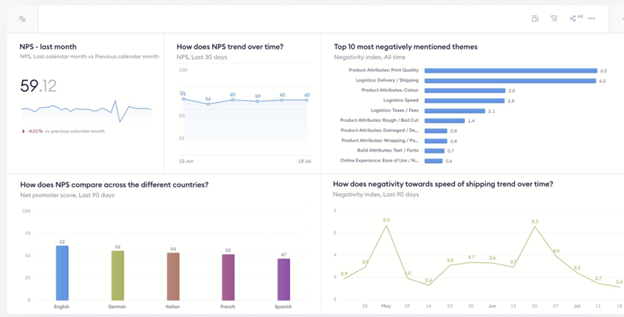
This text analysis tool online puts together texts from 50+ sources like reviews, social media, feedback, customer support, conversations, etc., to reveal a complete overview of your customer’s voice.
Chattermill’s primary strength is delivering actionable intelligence with the help of deep learning AI. And empowers your business with data-backed insights on how to improve your offering, operations and customer service.
Prominent features that make this app stand out are:
- Customer feedback and support data analysis – enhance customer loyalty and retention with personalised CX metrics and adaptable segmentation options that allow you to better understand the voice of your clients.
- Insight assistant – identify more helpful insights in a fraction of the time with their context-aware GPT solution.
- Impact analysis – find out what impacts your key metrics and depict the “why” behind your CSAT, NPS, and sentiment score. Obtain valuable insights to improve your CX decisions.
Chattermill is the tool of choice for customer-obsessed businesses like Booking.com, Amazon, Uber, H&M, Five Guys, Zappos, etc.
| Advantages | Disadvantages |
|---|---|
| User-friendly interface | No customisation option for reports |
| Advanced reporting capabilities | At times output is not very accurate |
| Powerful insights | Scarce impact related analytics |
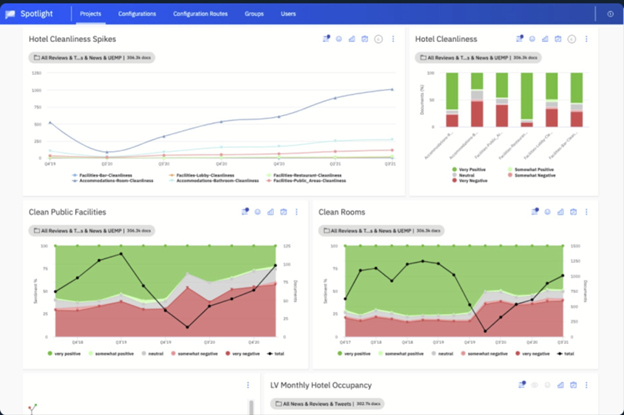
This automated text analysis platform promises to extract meaningful significance from unstructured text data.
Lexalytics has the capability to surface patterns and practical insights from a plethora of text formats like social media comments, customer reviews, surveys, customer feedback, and other documents.
To identify and explain the behaviour of your target audience and the “why” behind their decision, this tool uses natural language processing (NLP).
Among the most appreciated features of Lexalytics we count
- Advanced text analysis. It compares data from a variety of sources, groups the findings to depict trends and patterns and uncover hidden opportunities.
- Reveal essential insights delivered by a qualitative text analysis.
- 45+ Models built for specific industries. Looking to ameliorate the quality of its deliverables like higher sentiment accuracy, better topic identification or improved entity recognition, Lexalytics created pre-built models. These are dedicated to each industry and address industries like auto, pharma, and finance, among others.
Operates with 30+ languages. The software application is capable of processing texts and data from over 30 languages and is a pertinent option for international brands.
| Advantages | Disadvantages |
|---|---|
| Precise insights | Reporting feature not qualitative enough |
| AI-powered | Sometimes real-time processing may be slow |
| Industry-specific models | Data cleaning required |
| Multilingual | Weak performance for other languages except English |
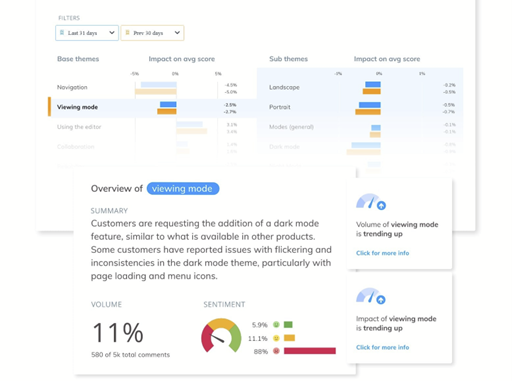
It is an AI-powered text analysis software that converts unstructured data and noisy feedback into detailed and accurate insights. Thematic excels at feedback analytics and discloses meaningful insights at scale.
This is an application powered by the latest technologies and conceived to be expanded by human inventiveness.
Researchers rely on this platform to help them improve customer experiences and profitability and concentrate more on the consumers’ needs.
Here are some prominent features that this platform proposes:
- Unified data analytics. Gather all your data from surveys, reviews, customer service and other sources in one place with seamless integrations. And Thematic will redact your data in a compliant and safe manner.
- Text and sentiment analytics. The platform categorises feedback based on sentiment and identifies repeated patterns. Next, it employs search tools to obtain applicable insights.
- Reporting and analysis. Use filters to refine and analyse customer feedback and get notifications when feedback shows issues and customer pain points.
Thematic’s collection of customers includes LinkedIn, Atlassian, Instacards, Doordash, Woolworth, Vodafone, Melodics, etc.
| Advantages | Disadvantages |
|---|---|
| Granular and accurate insights | Scorings at times are erroneous |
| Qualitative customer support | Learning curve |
| Real-time notifications | Getting the themes right takes time and effort |
| Multilanguage, and multiple integrations |
Azure AI-Language is a tool that uses natural language processing (NLP) to craft inviting customer experiences. It can identify keywords, summarise texts, execute sentiment analysis, and may be used to build conversational apps.
Based on Language, you have the possibility to create customisable AI models that can be trained and evaluated without machine learning knowledge.
The most important features that make this text analysis solution appealing are:
- Concepts identification – extracts and labels key data within texts and identifies entities like events, persons, organisations, etc.
- Documents resume – summarises conversations and various documents to understand topics and sentiment.
- Sentiment analysis – helps you understand precisely what your clients feel and their thoughts concerning your brand and products by mining opinions.
- Conversational experiences creation – conceive your own natural language model personalised for your users and your industry.
| Advantages | Disadvantages |
|---|---|
| Robust and flexible platform | Steep learning curve |
| AI and ML powered | Complex interface |
| Personalisation capabilities | Complex pricing model |
| Scalability | Confusing customer libraries |
| Security features |
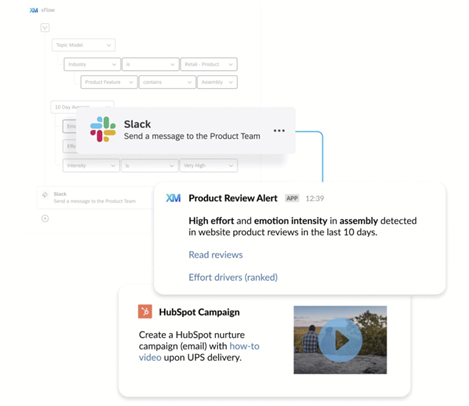
Clarabridge is now part of Qualtrics, creating a mighty conversational analytics platform able to understand the intent and emotions of both clients and employees, no matter where they express them.
Qualtrics promises to allow your business to act on all types of experience data and have a comprehensive overview of what’s happening in your environment and why. The platform delivers advanced insights in real-time via 150+ industry-specific natural language models.
Here are the features that get their clients’ attention:
- Improve experiences via automation – Use the right tools to ameliorate customer experiences and streamline processes simultaneously.
- Identify actions to minimise churn – Know exactly what each client needs and what to offer to cover those needs, no matter the customer journey stage.
- Extensive connectivity for comprehensive data collection – Having 100+ connectors for data integration, the platform covers various feedback sources, from chat and surveys to social media and call centre records.
Counting over 13,500 customers across the globe, Qualtrics collaborated with more than 85% of the companies listed by Fortune 500: Coca-Cola, Samsung, Sony, Spotify, Johnson & Johnson, Toyota, etc.
| Advantages | Disadvantages |
|---|---|
| Top-level tools | Average customer support |
| Advanced analytics capabilities | Limited personalisation available for some features |
| Extensive data collection sources | |
| Multilingual |

